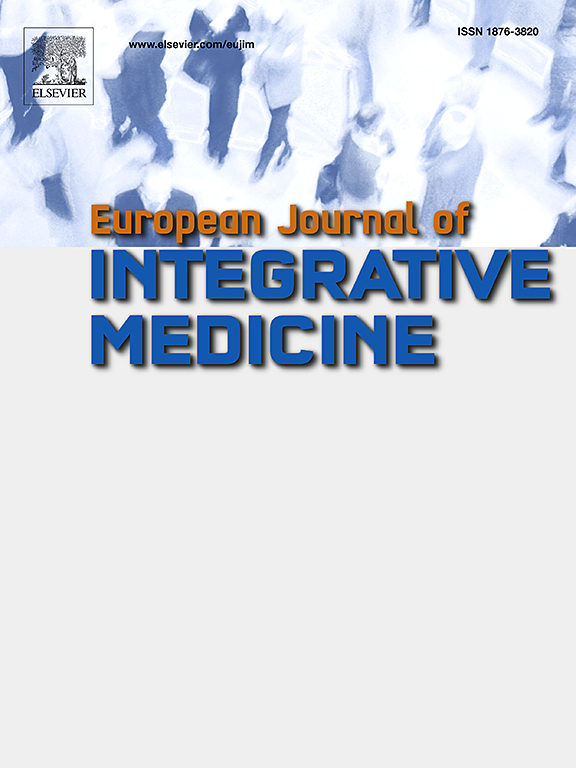使用干预措施描述和复制模板 (TIDieR) 检查表确定反射疗法干预措施报告质量的基准:系统回顾
IF 1.9
4区 医学
Q3 INTEGRATIVE & COMPLEMENTARY MEDICINE
引用次数: 0
摘要
简介反射疗法是一种辅助疗法,其理论基础是脚部、手部、面部和耳朵上的不同穴位与身体的不同部位相对应,每个穴位都代表一个反射区。反射疗法的做法各不相同,没有一种 "标准 "方法。并非所有反射疗法研究都有足够高标准的文献记录,因此无法对研究进行复制,也无法在荟萃分析中对研究数据进行合并,从而支持这种辅助疗法向循证实践发展。为了找出反射疗法干预报告中的具体不足之处,并提供一个基准,用于衡量反射疗法干预报告中包含的细节方面的任何未来变化,我们使用了干预描述和复制模板(TIDieR)检查表来评估现状。在所评估的 12 个 TIDieR 要素中,大多数研究对四个要素(2:为什么、6:如何、7:在哪里以及 8:何时和多少)的处理都令人满意。有两个要素(9:量体裁衣和 12:实际效果如何)的符合程度为中等,有四个 TIDieR 要素(1:简要名称、3:什么材料、4:什么程序和 5:谁)在所有研究中的符合程度主要为不充分,有两个要素(10:修改和 11:计划如何)很少包含在所分析的研究中。本系统综述确定了干预措施中记录不够详细的具体领域,以突出需要改进的领域,并为今后的研究提供一个衡量干预措施报告质量的基准。作为本次综述的一部分,收集到的数据被用作后续研究的输入数据,该研究编制了与 TIDieR 核对表一起使用的反射疗法特定指南。本文章由计算机程序翻译,如有差异,请以英文原文为准。
A benchmark for the quality of reflexology intervention reporting using the template for intervention description and replication (TIDieR) checklist: A systematic review
Introduction
Reflexology is a complementary therapy based on the theory that different points on the feet, hands, face, and ears correspond with areas of the body, each being represented as a reflex. Different reflexology practises exist, and there is not one ‘standard’ approach. Not all reflexology studies are documented to a sufficiently high standard to allow research studies to be replicated and their data combined within meta-analysis, which would support a move to evidence-based practice for this complementary therapy. To identify specific shortfalls within reflexology intervention reporting, and to provide a benchmark which could be used to measure any future changes in the detail included in reflexology intervention reporting, the Template for Intervention Description and Replication (TIDieR) checklist has been used to assess the current situation.
Methods
A systematic review was carried out on studies published in 2021 and each study scored using the 12 TIDieR elements for compliance.
Results
A total of 420 references were identified, resulting in 41 eligible studies. Amongst the 12 TIDieR elements assessed, four elements (2: Why, 6: How, 7: Where, and 8: When and how much) were consistently addressed satisfactorily by the majority of the studies. Two elements (9: Tailoring and 12: How well actual) exhibited moderate levels of compliance, four TIDieR elements (1: Brief name, 3: What materials, 4: What procedures, and 5: Who) were predominantly addressed inadequately across the studies and two elements (10: Modifications and 11: How well planned) were rarely included in the studies analysed.
Conclusion
Many studies did not adequately report the reflexology intervention, which inhibits implementation (and discontinuation), replication, and research synthesis. This systematic review has identified the specific areas of the intervention which are not being documented with sufficient detail in order to highlight areas requiring improvement and produce a benchmark against which the quality of the intervention reporting can be measured in future studies. Data collected as part of this review have been used as input into a follow-up study which has produced reflexology specific guidance to be used with the TIDieR checklist.
Funding
No funding was received for this project.
求助全文
通过发布文献求助,成功后即可免费获取论文全文。
去求助
来源期刊

European Journal of Integrative Medicine
INTEGRATIVE & COMPLEMENTARY MEDICINE-
CiteScore
4.70
自引率
4.00%
发文量
102
审稿时长
33 days
期刊介绍:
The European Journal of Integrative Medicine (EuJIM) considers manuscripts from a wide range of complementary and integrative health care disciplines, with a particular focus on whole systems approaches, public health, self management and traditional medical systems. The journal strives to connect conventional medicine and evidence based complementary medicine. We encourage submissions reporting research with relevance for integrative clinical practice and interprofessional education.
EuJIM aims to be of interest to both conventional and integrative audiences, including healthcare practitioners, researchers, health care organisations, educationalists, and all those who seek objective and critical information on integrative medicine. To achieve this aim EuJIM provides an innovative international and interdisciplinary platform linking researchers and clinicians.
The journal focuses primarily on original research articles including systematic reviews, randomized controlled trials, other clinical studies, qualitative, observational and epidemiological studies. In addition we welcome short reviews, opinion articles and contributions relating to health services and policy, health economics and psychology.
 求助内容:
求助内容: 应助结果提醒方式:
应助结果提醒方式:


